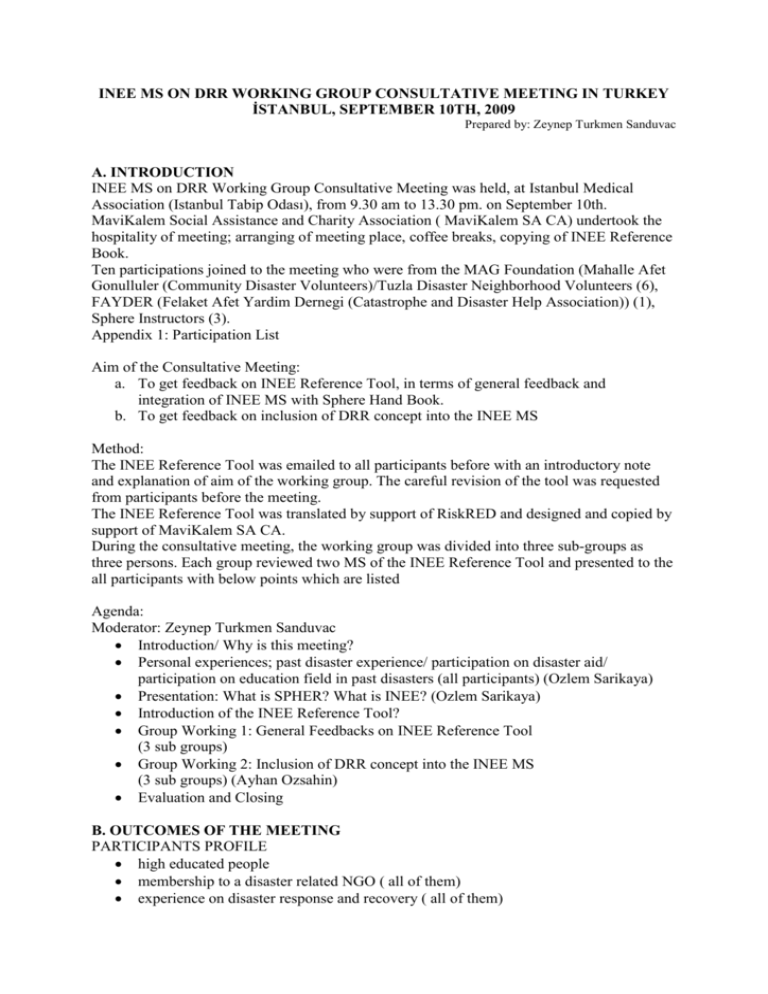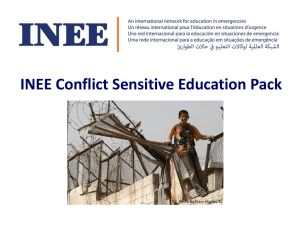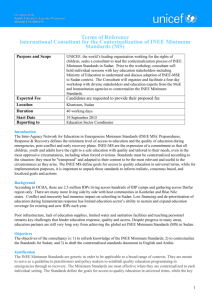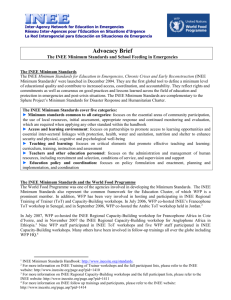INEE MS ON DRR WORKING GROUP CONSULTATIVE MEETING
advertisement

INEE MS ON DRR WORKING GROUP CONSULTATIVE MEETING IN TURKEY İSTANBUL, SEPTEMBER 10TH, 2009 Prepared by: Zeynep Turkmen Sanduvac A. INTRODUCTION INEE MS on DRR Working Group Consultative Meeting was held, at Istanbul Medical Association (Istanbul Tabip Odası), from 9.30 am to 13.30 pm. on September 10th. MaviKalem Social Assistance and Charity Association ( MaviKalem SA CA) undertook the hospitality of meeting; arranging of meeting place, coffee breaks, copying of INEE Reference Book. Ten participations joined to the meeting who were from the MAG Foundation (Mahalle Afet Gonulluler (Community Disaster Volunteers)/Tuzla Disaster Neighborhood Volunteers (6), FAYDER (Felaket Afet Yardim Dernegi (Catastrophe and Disaster Help Association)) (1), Sphere Instructors (3). Appendix 1: Participation List Aim of the Consultative Meeting: a. To get feedback on INEE Reference Tool, in terms of general feedback and integration of INEE MS with Sphere Hand Book. b. To get feedback on inclusion of DRR concept into the INEE MS Method: The INEE Reference Tool was emailed to all participants before with an introductory note and explanation of aim of the working group. The careful revision of the tool was requested from participants before the meeting. The INEE Reference Tool was translated by support of RiskRED and designed and copied by support of MaviKalem SA CA. During the consultative meeting, the working group was divided into three sub-groups as three persons. Each group reviewed two MS of the INEE Reference Tool and presented to the all participants with below points which are listed Agenda: Moderator: Zeynep Turkmen Sanduvac Introduction/ Why is this meeting? Personal experiences; past disaster experience/ participation on disaster aid/ participation on education field in past disasters (all participants) (Ozlem Sarikaya) Presentation: What is SPHER? What is INEE? (Ozlem Sarikaya) Introduction of the INEE Reference Tool? Group Working 1: General Feedbacks on INEE Reference Tool (3 sub groups) Group Working 2: Inclusion of DRR concept into the INEE MS (3 sub groups) (Ayhan Ozsahin) Evaluation and Closing B. OUTCOMES OF THE MEETING PARTICIPANTS PROFILE high educated people membership to a disaster related NGO ( all of them) experience on disaster response and recovery ( all of them) experience on working at tent cities (most of them) experience on informal education ( trainings to kids and adults) in past disasters ( four of them) Except three Sphere Instructors, none of them are familiar with Sphere MS and INEE MS FEEDBACKS ON THE REFERENCE TOOL (To get feedback on INEE Reference Tool, in terms of general feedback and integration of INEE MS with Sphere Hand Book) Participants’ general feedbacks on the Reference Tool It needs a background brief note The Reference Tool as it like that is not efficient to give an idea about the INEE MS. The PPT Introduction of INEE MS and the Handbook are useful to have an idea about the concept of the INEE MS. The adaptation of INEE Reference Tool is needed to Turkey; adaptation is very context-specific (local, regional, national priority setting needed). The group is willing to work on adaptation of the INEE MS Reference Tool. ( ½ day more in their place where in Tuzla) GROUP WORK 1 Participants’ feedbacks on the context of Reference Tool Participants’ feedbacks about standards, key indicators and guidance notes were listed below. Working Group1 Community Participation Analysis Standard 1: Participation Emergency-affected community members actively participate as transparently and fairly in assessing, planning, implementing, monitoring and evaluating the education programme. Key Indicators: Learners (all target group) are divided into based on age and education level The trainings will be given in where and in what conditions are determined and announced by community leaders and members The trainings (curriculums) are prepared and applied according to the education level and capacity of target groups National education authorities, related NGO members joined at the capacity development training programs in order to work together in the disaster field Impact evaluations and efficiency measurements of trainings are included in to all programs from the design phases Guidance Notes: Trainings/ curriculums are prepared and applied on based on cultural structure of target groups NGO’s are participated in to all level of disaster works in the field Preparation of trainings as a joint effort with provincial education authorities, local authorities, NGOs and disaster affected peoples Trainings are focused on building hope and capacity building Standard 2: Resources Key Indicators: National education authorities, related NGO members and disaster affected community members works together to defining, allocations and distribution of resources (including volunteer teachers, financial resources, equipments, etc.) Working Group 2 Access and Learning Environment Teaching and Learning Standard 1: Curricula Guidance Notes: Participatory curriculum development/adaptation takes into consideration the training needs of the learners Standard 3: Instruction Guidance Notes: Support active engagement motivation for teaching and learning Working Group 3: Teachers and Other Education Personnel Education Policy and Coordination Standard 1: Policy formulation and Enactment Key Indicators National and provincial education authorities attend to the in service trainings on education in emergencies (the INEE MS adaptation to Turkey is highlighted) Reducing and undertaking – in case of necessity- costs of education Standard 2: Planning and Implementation The continuity of education is planned and provided Standard 3: Coordination Guidance Notes Transparent, fair and coordinated approaches to financing Transparent and fair Monitoring and Evaluation mechanisms GROUP WORK 2 ( To get feedback on inclusion of DRR concept into the INEE MS) Community Participation Participation Religion leaders role in informal training is vital, in order to give right messages about misinterpreting of ‘faith’ for DRR Disaster affected community members and leaders (teachers, religion officials, headmans) are actively involve in dissemination of DRR programs DRR trainings are conceptualized and localized by involving of disaster affected community members Resources Community resources are used to develop, adapt and disseminate DRR education Community resources are allocated to provide DRR materials& equipments in education environments; such as, at schools, at tent cities, etc. (NSM applications, logistics; first aid kits, food&water, blankets, etc. Response strategy Valid indicators of DRR trainings are identified; localized, conceptualized, drr skills based (life saving skills; fire; health, search & rescue, communication, leadership of incident, evacuation, etc.,) trainings. Access and Learning Environment Protection and well-being Back up of the learning environments Learning environments are structurally and non structurally safe Learning environments has enough space for meeting area Learning environments are safe for evacuation Learning environments provide needed care for kids in case of disaster Teaching and Learning Training School administrations, teachers, school workers, members of the school-family unit and students are trained on DRR according to needs and circumstances. Teachers and Other Education Personnel Education Policy and Coordination Policy Formulation and Enactment Establishment of DRR education facilities by actively NGO actors permitted DRR trainings are adapted to marginalized groups Coordination Joint policy development for all related actors on DRR and trainings C. ATTENTION POINTS OF MEETING Participants mostly focused on preparedness of disasters Participants defined “community” as disaster-affected people and NGO members who represents survivals/affected people. Participants highlighted that formal education in emergencies is mainly duty of National Ministry of Education (Province National Education Directorate) Implementation of all formal education activities are needed MoE’s (provincial based) supervision, monitoring and evaluation However, preparedness of NGO’s on education in emergencies is very important. Therefore, INEE MS Handbook and training program would be very useful for preparedness of related NGO’s ; from aspects of both NGO’s own activities in disaster field and cooperation with national education authorities and also lead them in terms of INEE MS for education continuity. Sonraki Adımlar: INEE İngilizce dokümanı katılımcılara iletilecek. Dileyen katılımcılar, tercüme doküman üzerinde değişiklik önerilerini Zeynep Türkmen’e iletecekler. ( 17 Eylül’e kadar) Gruptan geri bildirim gelmesi durumunda – gerekirse- Tuzla’da doküman üzerinde ½ günlük bir toplantı daha yapılacak. Zeynep Türkmen grup çalışmalarında yapılan sunumları derleyerek gruba görüş için gönderecek. (iki hafta içinde) Appendix 1 INEE MS ON DRR WORKING GROUP MEETING _ SEPTEMBER 10, 2009 AFET RISKLERININ AZALTILMASINDA INEE ASGARI STANDARTLARI CALISMA GRUBU TOPLANTISI_10 EYLUL 2009
![View DRR Presentation Day 2 [PPT 774.00 KB]](http://s2.studylib.net/store/data/005450963_1-d9a539224e4e88c2b7c6d22d8b201673-300x300.png)


![View DRR Presentation Day 1 [PPT 1.07 MB]](http://s2.studylib.net/store/data/005562166_1-09058b36ec0804e4de33b95a0df46bfd-300x300.png)



